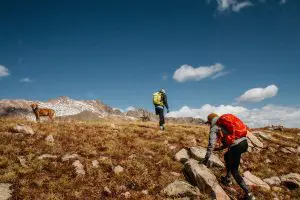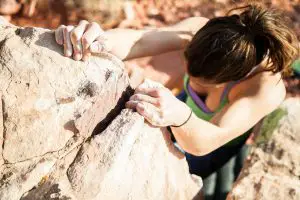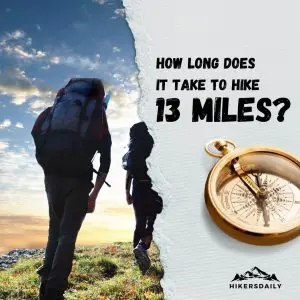Fear Of Hiking Downhill: Overcome Your Hiking Anxiety
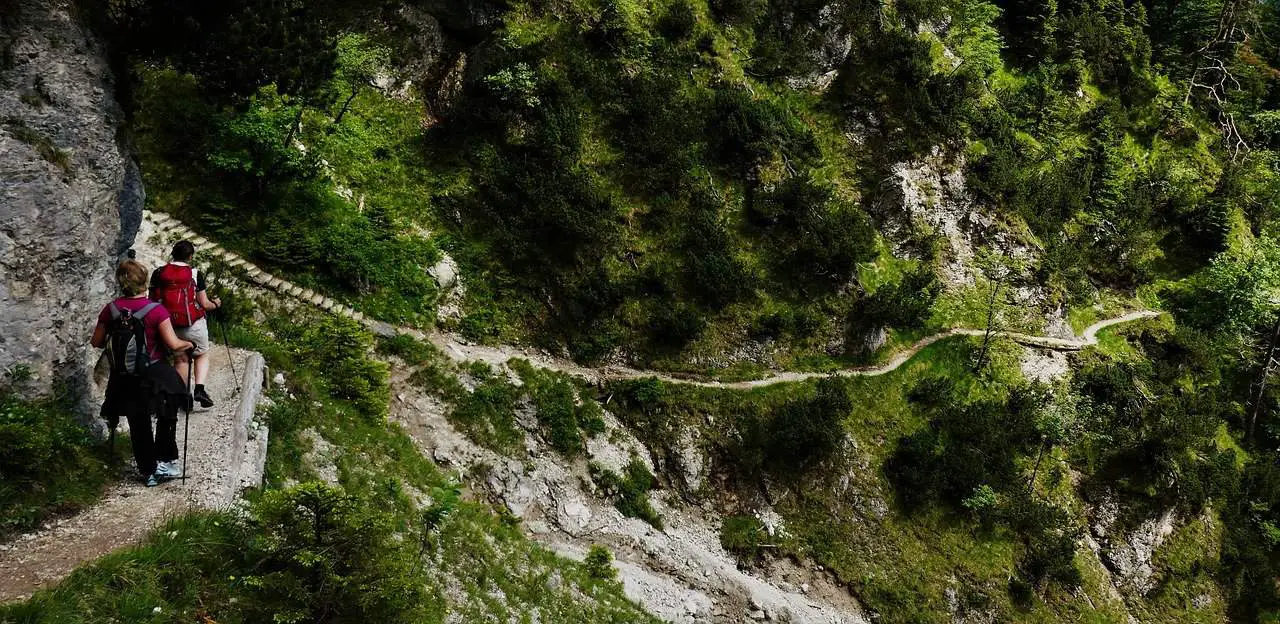
Hiking is a fun exercise that helps burn calories, build muscles, and improve balance. However, the fear of hiking downhill seems to be a challenge for beginners and even expert hikers.
I couldn’t even look back without feeling dizzy, nervous, and anxious when I first started hiking. It felt like the ground would open up and swallow me whole if I took one wrong step.
Hiking uphill was no problem. But as soon as we reached the peak and started our descent, that fear rained down on me like an avalanche.
Fear of hiking downhill, in certain instances, can be Bathmophobia. Bathmophobia is the extreme fear of steep slopes or stairs. This fear takes the fun out of hiking for some people, making it an unpleasant experience. Most times, hikers get scared of this fun exercise because they do not do it right or do not use the necessary equipment.
So, read on to know more about this fear and how to get over the fear of downhill hiking.
Quick Links
What is Bathmophobia?
Bathmophobia is, in simple terms, the fear of stairs and slopes, irrespective of their steepness. This fear is seen in both children and adults, and the symptoms differ from person to person.
How do you know somebody with Bathmophobia?
They feel anxious when watching videos or seeing pictures of slopes or stairs and trying to avoid them at all costs. Other symptoms include; chest pain, increased heart rate, sweating or shaking, nausea, and shortness of breath.
Before we classify a fear for downhill hiking as Bathmophobia, we consider the following factors;
- Rationality: A person with Bathmophobia experiences intense anxiety and fear when confronted with stairs or slopes. This fear is irrational as the object of their fear poses little or no danger.
- Disruptive: It limits a person’s work, hobbies, relationships, and more. It disrupts the flow of events, and a person suffering from Bathmophobia would seek an alternative route instead of taking stairs.
- Duration: In diagnosing a person with Bathmophobia, time is a factor. Until the fear persists for more than six months, it is not considered Bathmophobia.
Since we now know how to recognize Bathmophobia, let us discuss its causes.
Causes of Bathmophobia
A variety of factors could cause this disorder, including;
- Experience: if you had a negative experience with stairs or slopes early in life or saw somebody else’s negative experience, you can as well develop bathmophobia
- Learned Behavior: If the parents of a child or somebody close to the child has Bathmophobia, there is a high tendency that the child would develop the condition too.
- Genetics: Not everybody has negative experiences or learned phobia from somebody else. Some are genetic.
Why Is Hiking Downhill Harder?
For most people, hiking downhill is harder than hiking uphill. Here are a few reasons why:
- It is more tiring on the legs: Your calf muscles have to work extra hard to control your descent when you go downhill. This is especially true if the terrain is steep or uneven.
- Your knees take a beating: Walking downhill puts a lot of stress on your knees. If you have any knee problems, it is best to avoid hiking downhill.
- It is harder on the feet: constant pounding on the feet can lead to pain and even injuries. To avoid this, make sure to wear comfortable shoes and take breaks often.
- You can’t see where you are going: When you walk downhill, your view is typically obstructed by the terrain. This can make it difficult to see potential hazards. To avoid this, take your time and pay attention to your surroundings
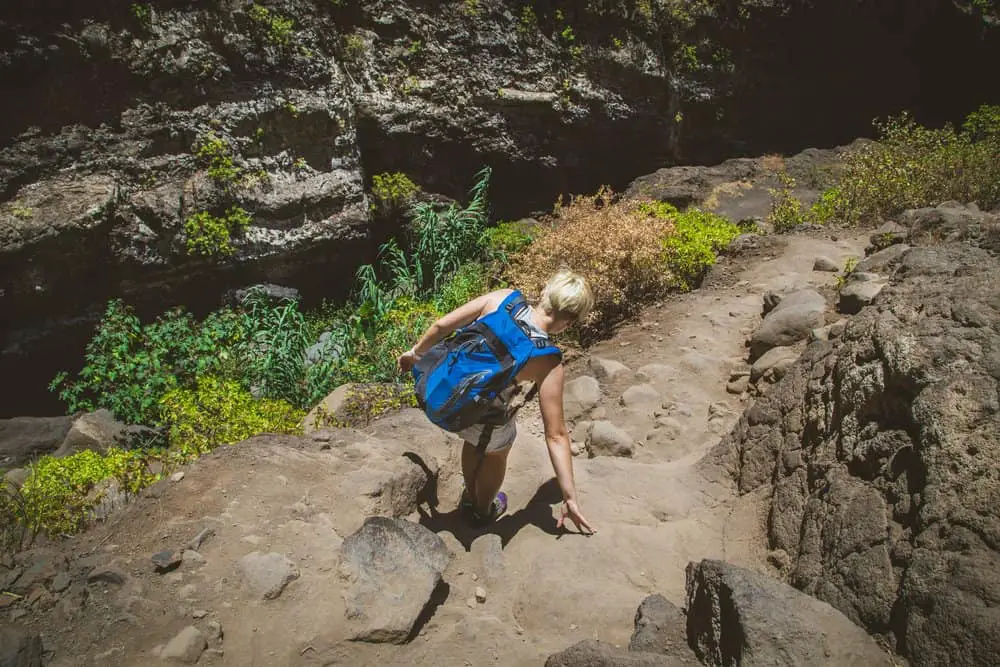
How Do I Get Over My Fear Of Hiking Downhill?
Do you have a passion for climbing mountains and hiking paths, but the fear of hiking downhill keeps you home? Know you are not alone, and this section is especially for you. There are many ways to overcome your phobia, and staying home, unfortunately, is not one of them.
Below are some tips you could try:
Trekking Poles
Trekking poles are incredibly helpful during a hike, especially when hiking downhill. They help provide balance, support, and control your fear by building your confidence. Even if you do not have a phobia of hiking downhill, trekking poles help you deal with the challenge of hiking downhill with a heavy backpack.
When hiking downhill with your trekking poles, you can simply place the poles in front of you as trek, so they serve as support.
If you’re a beginner and haven’t used trekking poles, I would recommend these Cascade Mount Tech Trekking Poles.
Get Used To Heights – Practice, Practice, Practice
Want to deal with your fear of hiking downhill? Find a downhill hiking trail close to you, walk the trail once or twice a week. The first step of getting over your phobia is getting used to being in high places with a little bit of exposure. After some time, you will find that your fear starts to dissipate.
Start Small
Start small, with short and easy trails before trying the longer and more challenging ones. It would help if you built up your confidence slowly by starting small and working your way up.
Visualize Your Success
Every time you attempt a new trial, take some time to visualize yourself being successful. It would help if you focused on the FEELING of success rather than the actual physical outcome. The more you focus on the feeling, the higher your chances of achieving it are.
Invest In The Right Hiking Shoes
While we all love to hike downhill in the most comfortable wear, hiking with tennis shoes, flip flops, or crocs is not advisable. On a hike, wearing poor-quality shoes can lead to twisted ankles, slipping, and falling.
Want a successful hike?
Then get quality hiking boots or hiking shoes, and you are halfway there. Hiking boots support your ankles, giving you more stability, keeping you safe, and ensuring your steps downhill are firm.
Take Short Steps
Running downhill is a bad idea if you deal with Bathmophobia, as it could lead to fatal mistakes and injuries. When you take small measured steps, you can focus on the trail. It also keeps you in a meditative state of mind. These steps help keep you aware of what is in front of you while helping you make informed decisions on where to place your feet.
Keep Upright
Keeping Upright means maintaining your center of gravity. Leaning too much when walking downhill might be fatal, as leaning causes your backpack to push forward, resulting in a fall.
When packing your backpack, keep heavy items close to your legs, not your back, so you would be able to maintain your center of gravity through the hike.
Stop And Admire The View
Lastly, when you are at the top of a hill or mountain, stop and take some time to enjoy the scenery. Appreciate nature’s beauty for a moment before continuing your hike. It will help to ease your mind and give you an incredible sense of achievement and confidence. Look at what you just conquered!
How Do You Hike Downhill Without Slipping?
There are usually two sides to hiking a hill or a mountain, uphill and downhill. While most people do not consider hiking downhill as tasking as hiking uphill, the number of slips and injuries from walking carelessly downhill is far more dangerous.
Want to hike downhill successfully without slips and injuries? Below are some tips you could employ.
Do not Lock your Knees
When you lock your knees, you expose them and your back to injuries. To hike downhill successfully, keep your knee joints loose. You can do this by bending your legs slightly when you walk.
Walk-in Zig-Zags
Walking in a straight line would make your path shorter and more difficult. Walking in a zig-zag or crisscross pattern would make the descent easier on your back and knees, although it makes the path a tad longer.
Tighten Your Shoelaces
A loosely laced hiking shoe exposes your ankle to injury risks. Tying your shoelaces tightly helps protect your foot while improving the ease of movement. You can also double-knot your laces for extra protection.
Watch Where You Step
You cannot be too careful watching where your footfall will land. A wrongly placed foot would cause the slip you are trying to avoid.
Also, walk with a heel-toe movement. Land with your heels first when you walk, as landing with your toes would cause a strain on your toe box and could cause damage to your toenails.
Use Your Hiking Poles
I have to repeat it because it’s that important. Hiking poles are essential pieces of equipment when hiking downhill. They help with your balance and give you extra support, making it easier to hike downhill without slipping or falling. If you don’t have hiking poles, you can use walking sticks found on the trail.
Conclusion
Fear of downhill hiking can be overcome by gradually exposing oneself to the activity. Focusing on the positive aspects of downhill hiking, such as the views and scenery, can also help lessen fear.
Finally, remember that everyone feels fear at some point during a hike, but it is essential to push through and enjoy the experience.
Have you ever experienced fear while hiking downhill? If so, how did you overcome it?

